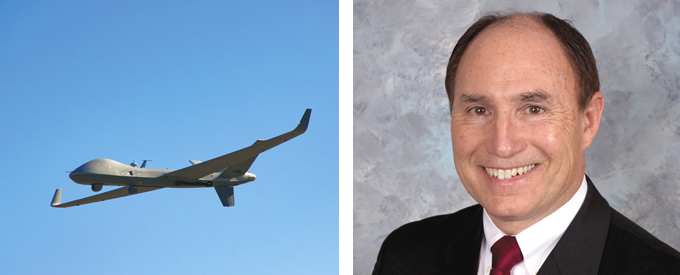2018-02-01
Maximizing GA-ASI RPA Potential in Middle East Airspace
General Atomics Aeronautical Systems, Inc. (GA-ASI), the industry leader in Remotely Piloted Aircraft (RPA) is celebrating 25th year in business providing long-endurance, mission-capable aircraft. GA-ASI is also supporting military forces in the Middle East. Nation Shield spoke to Jim Thomson, Regional Vice President of International Strategic Development for GA-ASI on the sidelines of UMEX about a range of topics related to RPAs. Excerpts:
What does General Atomics Aeronautical Systems, Inc. (GA-ASI) produce?
GA-ASI is the industry leader in Remotely Piloted Aircraft (RPA), with more than 800 aircraft produced for customers around the world and more than 4.9 million flight hours. We also design and manufacture radars, and electro-optic and related mission systems, including the Lynx multi-mode Radar. We’re celebrating our 25th year in business, providing long-endurance, mission-capable aircraft with integrated sensor and data link systems. We also produce a variety of ground control stations and sensor control/image analysis software, as well as offering pilot training at our Grand Forks, North Dakota Flight Test and Training Center, and a range of other support services.
GA-ASI produces a broad line of aircraft, but what are some of the common characteristics between platforms?
RPA share many attributes with manned aircraft, but a key differentiator with our platforms is persistence. Some of our aircraft can remain airborne for up to 42 hours – continuously performing ISR (Intelligence, Surveillance and Reconnaissance) and collecting data – without needing to refuel.
This record-setting endurance offers the potential to save lives through extended surveillance, and the ability to self-transit to other remote, and distant locations. We do this while still designing the aircraft to carry a range of important payloads.
We’re also focused on safety and reliability. You see that in our efforts to mature our RPA systems, improve designs and manufacturing processes, and enhance human-machine interface. We’re now designing our aircraft with certification and airworthiness in mind, so we’re meeting and even exceeding the reliability standards for manned aircraft, which includes fault-tolerant control systems and triple redundant avionics system architecture.
Is it difficult to get a RPA approved to fly in civilian airspace?
We had to fundamentally rethink the many aspects of our RPA design to enable both its airworthiness and gaining routine access to non-segregated airspace. One resulting RPA system, called MQ-9B SkyGuardian, forms the basis for the United Kingdom’s Royal Air Force’s (RAF) PROTECTOR program and will be certified to NATO standards (STANAG 4671). GA-ASI is the only RPA-producing company that’s taking on this certification initiative in a wholesale way.
GA-ASI initially developed the MQ-9B using IRAD (Internal Research & Development) funds, and introduced a number of hardware and software upgrades, such as improved structural fatigue and damage tolerance, and robust flight control software. Other enhancements enable operations in adverse weather, including icing conditions, and it’s designed to survive bird and lightning strikes. We also added a Detect and Avoid system that provides collision avoidance and is key to earning airworthiness certification.
Do the challenges of getting RPA certified to fly in civilian airspace vary from country to country? Are there globally accepted norms and regulations for RPA certification?
Many of the regulations from region to region are similar or identical, so we do expect that once we earn the first certification to fly in civil airspace, that subsequent certifications will be much easier. We’ve had great cooperation with the various global and local aviation authorities, and we feel good about the challenge we’ve undertaken. Global aviation is codified in the international framework by the International Civil Aviation Organization (ICAO) and GA-ASI is active in aligning international standards and practices with our 25 years of RPA design experience.
We are aware of your RPA’s importance to global military operations, but do you see any non-military applications for GA-ASI aircraft?
Our aircraft are being used for a number of non-military applications, including law enforcement, border patrol, fire detection, maritime patrol, and resource monitoring. Just recently, parts of the United States were devastated by hurricanes and our aircraft were part of the recovery efforts by giving authorities ‘eyes in the sky’ where they could see and evaluate impacted areas, and then help decision-makers dispatch appropriate and timely resources to the hardest hit areas.
Recently our aircraft were used in the firefighting efforts in California, where our sensor systems were used to track the movement of the fires and enable firefighters to deploy resources most effectively.
We are looking at integrating a WAMI (Wide Area Motion Indicator) sensor onto our aircraft that would enable wide-area surveillance over an area such as a city. This type of sensor is particularly useful for civilian police and fire departments for security, national infrastructure security, and disaster response and relief.
We believe that RPA could replace broadband function of satellites and cell towers in the near future. Our system could provide affordable broadband solutions to 70 percent of the world that is not connected or under connected. There is also tremendous opportunity in the international cargo market, where there is a clear gap between existing freight aircraft and cargo shipping. Ultimately, the technology that enables unmanned aircraft to operate routinely in civil airspace can be transitioned to manned aircraft to make them safer and more efficient.
Is GA-ASI pursuing any other initiatives in the Middle East?
While commercial applications for our aircraft abound, our core mission is supporting military forces. To that end, we are working with Middle East customers to provide an even higher return on investment for our aircraft by enabling a Manned-Unmanned Teaming (MUM-T) capability, which uses our RPA to provide surveillance information to ground forces, as well as manned aircraft like Apache helicopters. By adding the eyes and ears of the RPA to their battlefield picture, pilots in manned aircraft can grow the reach of their situational awareness and ultimately, improve mission capabilities.


No Comments